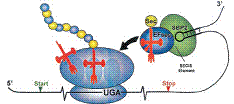Biochemistry, Department of

Vadim Gladyshev Publications
Document Type
Article
Date of this Version
February 2005
Abstract
Selenocysteine (Sec) is the 21st amino acid in the genetic code. Its tRNA is variably methylated on the 2’-Ohydroxyl site of the ribosyl moiety at position 34 (Um34). Herein, we identified a role of Um34 in regulating the expression of some, but not all, selenoproteins. A strain of knock-out transgenic mice was generated, wherein the Sec tRNA gene was replaced with either wild type or mutant Sec tRNA transgenes. The mutant transgene yielded a tRNA that lacked two base modifications, N6- isopentenyladenosine at position 37 (i6A37) and Um34. Several selenoproteins, including glutathione peroxidases 1 and 3, SelR, and SelT, were not detected in mice rescued with the mutant transgene, whereas other selenoproteins, including thioredoxin reductases 1 and 3 and glutathione peroxidase 4, were expressed in normal or reduced levels. Northern blot analysis suggested that other selenoproteins (e.g. SelW) were also poorly expressed. This novel regulation of protein expression occurred at the level of translation and manifested a tissue- specific pattern. The available data suggest that the Um34 modification has greater influence than the i6A37 modification in regulating the expression of various mammalian selenoproteins and Um34 is required for synthesis of several members of this protein class. Many proteins that were poorly rescued appear to be involved in responses to stress, and their expression is also highly dependent on selenium in the diet. Furthermore, their mRNA levels are regulated by selenium and are subject to nonsense-mediated decay. Overall, this study described a novel mechanism of regulation of protein expression by tRNA modification that is in turn regulated by levels of the trace element, selenium.


Comments
Published in THE JOURNAL OF BIOLOGICAL CHEMISTRY Vol. 280, No. 7, Issue of February 18, pp. 5542–5548, 2005.